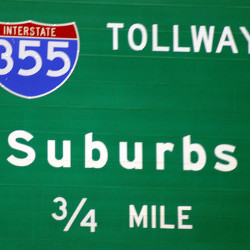 Fortune magazine’s Leigh Gallagher got a large amount of publicity over the summer for her book, The End of the Suburbs: Why the American Dream is Moving. Major newspapers did articles repeating her claims, and she expounded them on various blogs and talk shows: Millennials hate the suburbs, Baby Boomers are moving back to downtowns, people want to not have to use their cars, etc. Whether these things are true has important implications for transportation, so let’s look at what the data tell us.
Fortune magazine’s Leigh Gallagher got a large amount of publicity over the summer for her book, The End of the Suburbs: Why the American Dream is Moving. Major newspapers did articles repeating her claims, and she expounded them on various blogs and talk shows: Millennials hate the suburbs, Baby Boomers are moving back to downtowns, people want to not have to use their cars, etc. Whether these things are true has important implications for transportation, so let’s look at what the data tell us.
Demographer Wendell Cox took issue with the claim of a large migration of Baby Boomers from suburbs to downtowns. Using Census data for the 51 largest metro areas comparing 2010 with 2000, he found net out-migration of Boomers from the core city for all but a handful—and large net out-migration of Boomers from Chicago, Los Angeles, New York. Overall, the share of Boomers living in core cities declined by 10% over that decade.
Other evidence of people’s preferences comes from the 2011 Community Preference Survey commissioned by the National Association of Realtors. When respondents were given an array of housing choices, 80% preferred the single-family detached house, while only 8% chose an apartment or condo. And 61% preferred a place where “houses are built far apart on larger lots and you have to drive to get to schools, stores, and restaurants” over the 37% who chose a place where “houses are built close together on small lots and it is easy to walk to schools, stores, and restaurants.”
Given those findings, I was not surprised by findings released in August by the Commerce Department that the median house size rose to an all-time record high of 2,306 sq. ft. in 2012, slightly above the previous record of 2,277 sq. ft. at the height of the housing bubble in 2007.
Urban expert Joel Kotkin reported last month that America’s fastest-growing counties between 2010 and 2012 were suburban and exurban—places like Loudon County, VA (up 7.9%), Fort Bend County, TX (7.2%), and Osceola County, FL (7.0%). Kotkin comments that “It now seems clear that the preference for single-family houses did not change in the recession, but was just stunted by it. With construction starts up again—more than two-thirds single family—this trend is beginning to re-assert itself.” Mortgage lending is now at its highest level in five years. And the return of housing development in suburbs and exurbs is taking place even in the trendy San Francisco Bay Area and the formerly ailing Inland Empire east of Los Angeles.
Last spring Cox also analyzed Census data showing that U.S. suburbs are approaching jobs-housing balance. Suburban areas with more than one million population in 2011 now have 0.89 jobs per resident, compared with 1.35 in historic core municipalities. Overall, for major metro areas, 65% of all jobs are now in the suburbs, where 74% of all workers live. As Cox points out, prior to widespread auto ownership, metro areas were monocentric, with commuters riding streetcars and buses from suburbs to jobs in the central city. But thanks to cars and expressways, jobs have followed people to the suburbs in a major way. Again, this has major implications for urban transportation. It helps to explain why average commute times have not increased over the decades, despite increased traffic congestion. People and businesses relocated, facilitating shorter commutes in a polycentric metro area. And from the standpoint of transit systems, the old radial pattern, with all lines converging on “downtown,” is now less efficient than a grid system that connects everywhere to everywhere.
Sound urban transportation policy requires a solid grounding in how and where people and businesses choose to locate. Propagating (or believing) myths about the death of suburbs does not help in achieving cost-effective transportation.
- The Most Progressive Budget in Virginia’s History - December 21, 2019
- When is a Clean Water Act Permit Needed? - December 21, 2019
- Should U.S. Consider Modern Monetary Theory to Improve Economy? - December 21, 2019

